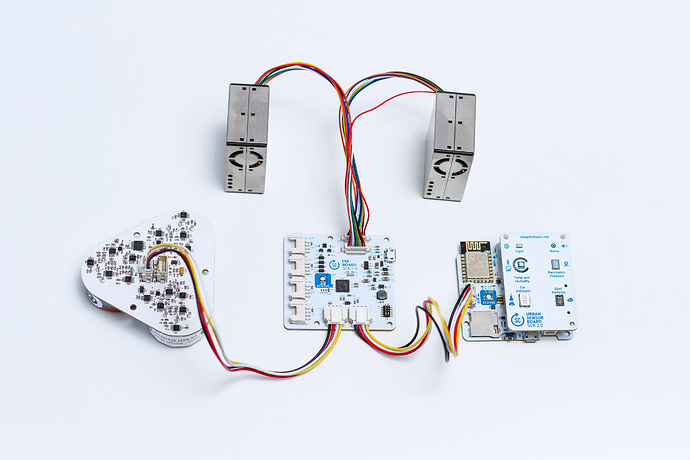Dear @aidrini
Apologies for not clarifying enough on this. The SCK2.0 was mainly a research-project version of the SCK from which we have learnt quite a lot. The SCK2.0 version was not sold openly for various reasons and due to that, the new SCK2.1 aims to improve it based on what we have learnt. For the new SCK2.1, the list of sensors is as follows:
| Metric |
Units |
Sensor |
| Atmospheric Pressure |
kPa |
NXP MPL3115A2 |
| Air Temperature / Relative Humidity |
ºC / %rh |
Sensirion SHT31 |
| VOCS, eCO2 |
ppm |
AMS CCS811 |
| Noise Level and FFT Spectrum |
dBa |
TDK ICS43432 |
| Particle Matter (PM1/2.5/10) |
ug/m3 |
Plantower PMS5003 |
| Ambient Light |
lx |
Rohm BH12721FVC |
The NO2 and CO sensors (SGX MICS4514) have been removed from the Urban board for many reasons. Mainly, the poor reliability of the measurements, the difficulty to calibrate them to obtain actual concentration values, and the battery consumption. As we have mentioned in the past, there have been some projects using the SGX MICS4514 as a low cost pollution sensor, but the list of cons from our point of view was larger than the potential gains. Instead, we have replaced it with a VOC/eCO2 sensor able to measure organic compouds and give proper concentration values. These values are also corrected for temperature and humidity effects.
That being said, we agree that a more complete sensing solution for urban air quality should have at least CO, NO2, PM and HC -hidrocarbons- (and surely we could think of many more, like O3, NH3…). Our aim is to cover the PM and HC with the combination of the Plantower PMS5003 and the AMS CCS811. For CO and NO2, we have worked on a more sophisticated board that can be plugged into the grove auxiliary port, and it’s based on electrochemical sensors. These sensors have been tested during the iScape project and give much more accurate measurements with much lower battery consumption. During the iScape project, they are all part of what we call the Smart Citizen Station, which is currently being deployed around Europe for evaluation. If successful, in the near future, we plan to include this board, or a single electrochemical sensor board to cope with the CO, NO2 measurements.
As for the SCK2.0 pictures that you see on seeedstudio, the thumbnails will change for the final SCK2.1, so don’t consider them fully representative.
Finally, as for the sensors offline, at the moment of writing this post, there are 131 kits online. I believe there is a small bug on the platform that is messing up the filters and that doesn’t show the online kits properly (I see them if I only unclick offline from the filters list).
And as a final comment: keep in mind that we don’t sell for profit, and that we would love to share the tools we build with everyone (data analysis, firmware, hardware components and so on).
Hopefully this helps! Let us know your comments!




